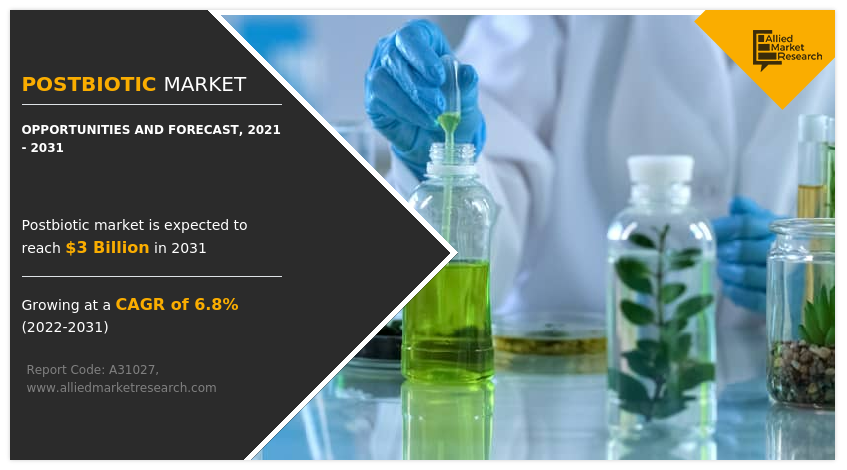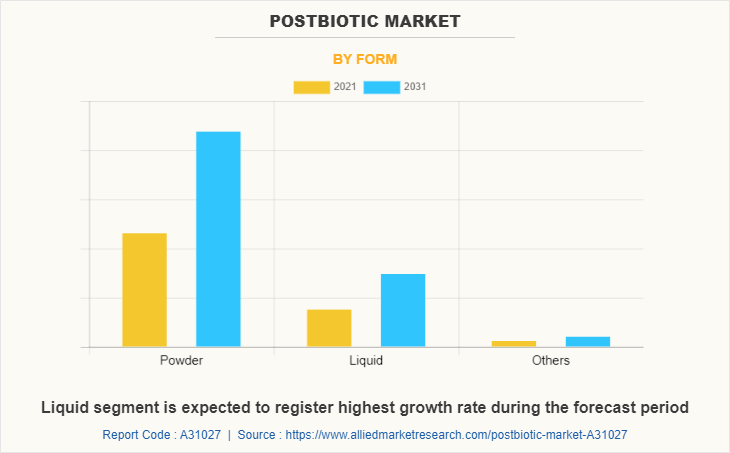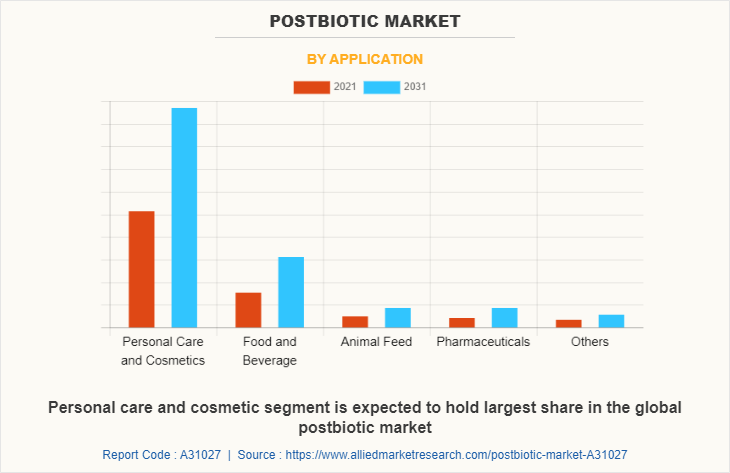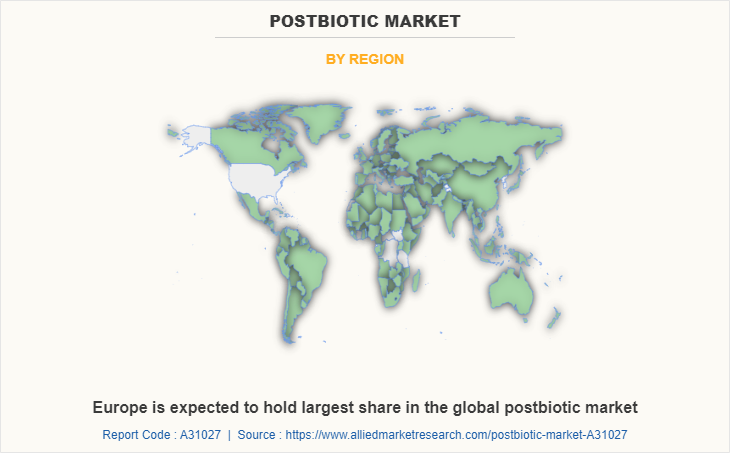Postbiotic Market Research, 2031
The global postbiotic market was valued at $1.6 billion in 2021, and is projected to reach $3 billion by 2031, growing at a CAGR of 6.8% from 2022 to 2031.

The postbiotic market is segmented into Form and Application.
Postbiotics are soluble factors secreted by live bacteria or released after bacterial lysis that provide physiological benefits to the host. They are also known as metabiotic, biogenic, or metabolites. When consumed in sufficient quantities, postbiotics have beneficial effects on the human body, such as improved gut health and decreased intestinal inflammation. Postbiotics are important in preventive healthcare because they strengthen the immune system, thus preventing disease.
Developed nations such as the U.S., Germany, France, Spain, Italy, Japan, and other developed nations around the world, as well as their consumers, are looking for customizable food, beverage, cosmetic, and dietary solutions to help them meet their own unique nutrition and personal health goals more aggressively. Consumers are no longer interested in general health and wellness products and programs. People in other emerging countries, such as China, South Korea, and the United Arab Emirates, have also become aware of the health benefits of consuming functional supplements and foods, and are thus adopting foods and supplements high in postbiotics, prebiotics, vitamins, and minerals. As Asia-Pacific consumers consume more almonds per person, developing countries are expected to lead the market growth.
Consumer lifestyle changes have been one of the major factors contributing to the growing popularity of functional supplements in developing economies. Customers' food habits are changing in Asia-Pacific countries as per capita income rises. The rise in aspiration and preference for a luxurious lifestyle has resulted in a significant increase in market size and overall postbiotic market demand. Furthermore, per capita income in Latin America and the Middle East has increased significantly over the last decade, which is expected to rapidly boost demand for luxury food in the coming years. Consumer spending on luxury food items is increasing rapidly, and fast food, bakery products, ice cream, and other lifestyle food products are becoming increasingly popular. Furthermore, sales of soy-based functional food products are increasing in developing economies such as India and China due to their high potential for phytosterol enrichment, which contributes significantly to the global postbiotic market size.
Postbiotics and other types of nutraceuticals, functional food, and beverage products have grown in popularity in recent years, resulting in a significant increase in their sales. As a result of their popularity and high sales revenue, many small businesses or organizations have begun producing low-quality versions of such products and selling them for profit. These low-quality and counterfeit products are made with inferior ingredients and are frequently contaminated with allergens and harmful chemicals. Many of these products are extremely hazardous to one's health if consumed. Furthermore, the packaging of such products is identical or very similar to that of good quality products, making it difficult for consumers to distinguish between the two, posing a serious threat to the postbiotic market demand.
Postbiotics and nutraceuticals are becoming increasingly popular as more consumers use them to supplement their regular diets. However, many consumers are looking for supplements that are both convenient and tasty, making such types of supplements easier to consume. Newer types of nutraceuticals, such as gummies, jellies, and soft gels, are being introduced to the market, and their popularity is growing. They come in a variety of shapes, sizes, flavors, and concentrations. Most of these nutraceuticals are intended for daily consumption, and thus these varieties allow consumers to consume these nutraceutical products like postbiotics on a daily basis if they are perceived to be enjoyable to consume.
The majority of postbiotics in animal feed are used in animal husbandry. Postbiotic feed components are used in poultry feed, cattle feed, and animal feed because of the numerous benefits they provide to the animals. With the addition of postbiotics in the feed, the large amounts of proteins, healthy fat, and amino acids present in animal feeds are easy to digest, and it helps the animals grow up properly and accumulate adequate muscle and fat to be harvested properly. Because of the benefits, it provides to animals, the use of postbiotic ingredients in commercial animal feed is rapidly increasing.
The postbiotic market is segmented on the basis of form, application, and region. As per form, the postbiotic market is classified into powder, liquid, and others. Depending on the application, it is categorized into personal care and cosmetics, food and beverage, animal feed, pharmaceuticals, and others. Region-wise, the market is divided into North America, Europe, Asia-Pacific, and LAMEA.

Powders are the most commonly used form of postbiotics, with the liquid form predicted to have the highest growth during the probiotic market forecast period. Powdered postbiotics are most commonly available in water or milk-soluble powder form. This powder is mixed into a drink, which is then consumed to provide nutrients and antioxidants. Postbiotic powders are an easy way to add nutraceuticals to your diet. These powders, which are widely available and extremely popular, may contain a variety of supplements that are included to enhance the powders’ benefits. Almost all of these powders are flavored, making them easier to consume. The majority of liquid postbiotics are intended for consumption by children and the elderly because they are easier to consume and absorb by the body. Because liquid postbiotics lose effectiveness when exposed to direct sunlight, they are packaged in dark brown or opaque bottles. Many liquid postbiotics are also flavored in various flavors to improve their taste and make them easier for children to consume.

Postbiotic applications in the cosmetics industry are high, and their applications in the food and beverage industry are expected to increase significantly in the future. Natural and functional cosmetic, beauty, and personal care products are becoming increasingly popular. The use of postbiotic ingredients in cosmetics improves the skin's health and helps to prevent side effects caused by other ingredients. Consumers recognize its detoxifying and sun-protection properties and are actively purchasing such products. As the demand for natural and functional cosmetic products grows, so will the use of postbiotic ingredients in manufacturing such cosmetics and personal care products. The rapid increase in the number of fitness and sports enthusiasts, as well as the consumers' preference for a healthy lifestyle, are expected to be key drivers for the global postbiotic market. Furthermore, increased athlete participation in sports at the national and international levels is expected to boost demand for functional beverages with postbiotics, accelerating market growth. Furthermore, the growing urbanized population, rising healthcare spending, and increasing cardiovascular, chronic, and obesity-related diseases, will lead to further adoption of postbiotics.

Europe is the largest consumer of postbiotics as European countries are developed, and they can easily adapt to new products. Furthermore, as the region's population becomes more aware of the availability of natural ingredients and their benefits, demand for such products is increasing. Many European countries are dominated by the fashion industry, and the use of nutraceuticals for skin improvement and repair is increasing in these countries. Nutraceuticals are well-known for their numerous skin benefits, and the majority of them have anti-aging properties. Nutraceuticals and supplements are widely consumed in North America. In terms of demand growth, the U.S. leads the way, with Canada and Mexico close behind. Postbiotics and nutraceuticals are gaining popularity as consumers seek out health supplements made from natural ingredients.
As the Asia-Pacific region's population grows, so does the demand for food, healthcare facilities, dietary supplements, and cosmetic products. Consumers in this region are becoming more aware of the beneficial properties of nutraceuticals as a result of positive results from Western countries. Due to this, various types of nutraceutical products are becoming more popular in the region.
Some of the major players analyzed in this postbiotic industry report that holds leading postbiotic market share are Sami-Sabinsa Group Limited, Woresan GmbH, Novachem SRL, ILDONG HOLDINGS CO., LTD., Church & Dwight Co., Inc, Danish Agro, Lamberti S.p.A., Cargill, Incorporated, Adare Pharma Solutions, Lactobio A/S, Archer Daniels Midland Company, Kirin Holdings Company, Limited, Bioflag Group, Probiotics Australia Pty., Ltd., Lesaffre, Otemchi Biotechnologies Pte. Ltd., SILAB, Mitsubishi Corporation, GeneFerm Biotechnology Co., Ltd., and KOREA BeRM co., Ltd.
Key Benefits For Stakeholders
- This report provides a quantitative analysis of the market segments, current trends, estimations, and dynamics of the postbiotic market analysis from 2021 to 2031 to identify the prevailing postbiotic market opportunities.
- Market research is offered along with information related to key drivers, restraints, and postbiotic market opportunity.
- Porter's five forces analysis highlights buyers' and suppliers' potency to enable stakeholders to make profit-oriented business decisions and strengthen their supplier-buyer network.
- In-depth analysis of the postbiotic market segmentation assists to determine the prevailing market opportunities.
- Major countries in each region are mapped according to their revenue contribution to the global market.
- Market player positioning facilitates benchmarking and provides a clear understanding of the present position of the market players.
- The report includes an analysis of the regional as well as global postbiotic market trends, key players, market segments, application areas, and postbiotic market growth strategies.
Postbiotic Market Report Highlights
| Aspects | Details |
| Market Size By 2031 | USD 3 billion |
| Growth Rate | CAGR of 6.8% |
| Forecast period | 2021 - 2031 |
| Report Pages | 189 |
| By Form |
|
| By Application |
|
| By Region |
|
| Key Market Players | KOREA BeRM co., Ltd, Kirin Holdings Company, Limited, Lactobio A/S, woresan GmbH, Otemchi Biotechnologies Pte. Ltd., Cargill, Incorporated, Church & Dwight Co., Inc., Danish Agro, Archer Daniels Midland Company, GeneFerm Biotechnology Co., Ltd., Adare Pharma Solutions, Mitsubishi Corporation, Probiotics Australia Pty., Ltd., ILDONG HOLDINGS CO., LTD., SILAB, Sami-Sabinsa Group Limited, Novachem SRL, Bioflag Group, Lesaffre, Lamberti S.p.A. |
Analyst Review
According to the CXOs of various companies, the twenty-first century has seen a rapid increase in business and the severity of people's lifestyles, particularly the office-going people who make up the majority of the world population. As a result, people are unable to devote enough time to healthy eating habits and exercise, which has resulted in a slew of health issues and complications. However, there has been an increase in consumer awareness of such issues, and consumers are now adopting healthy practices such as exercising and using postbiotics and other types of nutraceuticals.
Postbiotic products can be consumed daily or a few times per week, depending on the strength and potency of the ingredients. Most postbiotic products on the market are aimed at improving gut and intestinal health, but they may also include other ingredients such as vitamins and minerals, proteins, and amino acids to provide additional benefits. Some postbiotics can be combined with other types of healthy foods, such as powdered or liquid nutraceutical products added to juices or smoothies. It can also improve the taste of these foods because most nutraceutical products on the market come in a variety of flavors. Because these postbiotic products are made from food, they are considered safe for consumption and do not fall under the category of pharmaceutical products. Most countries do not strictly regulate nutraceuticals due to which they are widely available.
As more consumers adopt organic diets, engaged stakeholders in the postbiotic market are focusing on using organic and herbal ingredients in the production of their products, particularly in the Asia-Pacific region, which has a culture of herbal and Ayurvedic medicine. Furthermore, as veganism becomes more popular, there is an increase in demand for vegan postbiotic products.
The postbiotic market was valued at $1,579.0 million in 2021, and is estimated to reach $3,025.8 million by 2031
The Global Postbiotic Market is expected to register a CAGR of 6.8% during the forecast period
2021 is the base year calculated in the Global Postbiotic Market.
The estimated industry size of the postbiotic market is $1,675.3 Million in 2022
Sami-Sabinsa Group Limited, Woresan GmbH, Novachem SRL, ILDONG HOLDINGS CO., LTD., Church & Dwight Co., Inc., Danish Agro, Lamberti S.p.A., Cargill, Incorporated, Adare Pharma Solutions, Lactobio A/S, Archer Daniels Midland Company, Kirin Holdings Company, Limited, Bioflag Group, Probiotics Australia Pty., Ltd., Lesaffre, Otemchi Biotechnologies Pte. Ltd., SILAB, Mitsubishi Corporation, GeneFerm Biotechnology Co., Ltd., and KOREA BeRM co., Ltd. are the top companies to hold the market share in Postbiotic
By form, application, and region are the segments of the Global Postbiotic Market
Forecast period in the Global Postbiotic Market report is 2022-2031.
The leading applications of postbiotic markets are personal care and cosmetics, food and beverage, animal feed, pharmaceuticals, and others
Loading Table Of Content...



